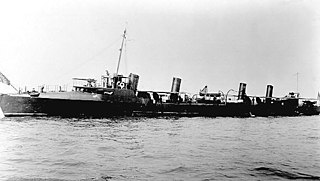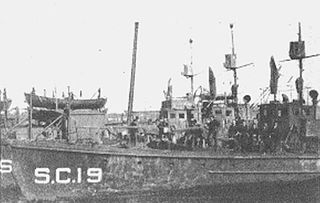Related Research Articles
The New York Shipbuilding Corporation was an American shipbuilding company that operated from 1899 to 1968, ultimately completing more than 500 vessels for the U.S. Navy, the United States Merchant Marine, the United States Coast Guard, and other maritime concerns. At its peak during World War II, NYSB was the largest and most productive shipyard in the world. Its best-known vessels include the destroyer USS Reuben James (DD-245), the cruiser USS Indianapolis (CA-35), the aircraft carrier USS Kitty Hawk (CV-63), the nuclear-powered cargo ship NS Savannah, and a quartet of cargo-passenger liners nicknamed the 4 Aces.

The second USS Dale was a Bainbridge class destroyer in the United States Navy.

The first USS Whipple (DD-15) was a Truxtun-class destroyer in the United States Navy, named for Abraham Whipple.

Three Truxtun-class destroyers were built for the United States Navy. Part of the original 16 destroyers authorized by Congress on 4 May 1898 for the fiscal year 1899 program, they were commissioned in 1902. They were very similar to their Bainbridge-class contemporaries, except for mounting six 6-pounder (57 mm) guns instead of five. They were considered the most successful of the first 16 US Navy destroyers, and were succeeded by the larger Smith class.

The third USS Lawrence (DD-8) was a Lawrence-class destroyer, which was a sub-class of Bainbridge-class destroyer, in the United States Navy. She was named for Captain James Lawrence.

The first USS Macdonough (DD-9) was a Lawrence-class destroyer, which was a sub-class of Bainbridge-class destroyer, in the United States Navy. She was named for Commodore Thomas Macdonough

The second USS Paul Jones was a Bainbridge-class destroyer in the United States Navy. She was named for John Paul Jones.

The second USS Perry was a Bainbridge-class destroyer in the United States Navy. She was named for Commodore Oliver Hazard Perry.

The first USS Stewart was a Bainbridge-class destroyer in the United States Navy. She was named for Rear Admiral Charles Stewart.

USS Smith (DD–17) was the lead ship of Smith-class destroyers in the United States Navy. She was the first ship named for Lieutenant Joseph B. Smith. Entering service in 1909, the destroyer was placed in reserve in 1912. She was reactivated for World War I and, following the war, was used as a test ship for aerial bombing. In 1921, the vessel was sold for scrapping.

The Federal Shipbuilding and Drydock Company was a United States shipyard in New Jersey active from 1917 to 1948. It was founded during World War I to build ships for the United States Shipping Board. Unlike many shipyards, it remained active during the shipbuilding slump of the 1920s and early 1930s that followed the World War I boom years. During World War II, it built merchant ships as part of the U.S. Government's Emergency Shipbuilding program, at the same time producing more destroyers for the United States Navy than any yard other than the Bath Iron Works. Operated by a subsidiary of the United States Steel Corporation, the shipyard was located at Kearny Point where the mouth of the Hackensack River meets Newark Bay in the Port of New York and New Jersey.
USS SC-255, sometimes styled as either Submarine Chaser No. 255 or S.C.-255, was an SC-1-class submarine chaser built for the United States Navy during World War I. Like most members of her class, she was not named and known only by her designation.

USS SC-48, sometimes styled as either Submarine Chaser No. 48 or S.C.-48, was an SC-1-class submarine chaser built for the United States Navy during World War I. Like most members of her class, she was not named and known only by her designation.

USS SC-49, prior to July 1920 known as USS Submarine Chaser No. 49 and USS S.C. 49, was an SC-1-class submarine chaser built for the United States Navy during World War I.

USS SC-19, until July 1920 known as USS Submarine Chaser No. 19 or USS S.C. 19, was an SC-1-class submarine chaser built for the United States Navy during World War I.
USS SC-34, until July 1920 known as USS Submarine Chaser No. 34 or USS S.C. 34, was an SC-1-class submarine chaser built for the United States Navy during World War I.

USS SC-35, until July 1920 known as USS Submarine Chaser No. 35 or USS S.C. 35, was an SC-1-class submarine chaser built for the United States Navy during World War I.

USS SC-37, until July 1920 known as USS Submarine Chaser No. 37 or USS S.C. 37, was an SC-1-class submarine chaser built for the United States Navy during World War I.

USS SC-42, until July 1920 known as USS Submarine Chaser No. 42 or USS S.C. 42, was an SC-1-class submarine chaser built for the United States Navy during World War I.

USS SC-44, until July 1920 known as USS Submarine Chaser No. 44 or USS S.C. 44, was an SC-1-class submarine chaser built for the United States Navy during World War I.
References
- ↑ The Federal Reporter, Vol. 138, p. 586
- ↑ "A Message to Industrial Philadelphia". Evening Public Ledger. Philadelphia. April 16, 1919.
- ↑ "Stockholders Control". The Philadelphia Inquirer. 14 February 1925.
- ↑ "J.G. Hitner dies; Scrap Steelman". The Philadelphia Inquirer. 13 November 1950.
- 1 2 "Just a few of the War Craft that have been Discarded". Evening Public Ledger. Philadelphia. July 8, 1922. p. 22.
- This article incorporates text from the public domain Dictionary of American Naval Fighting Ships .